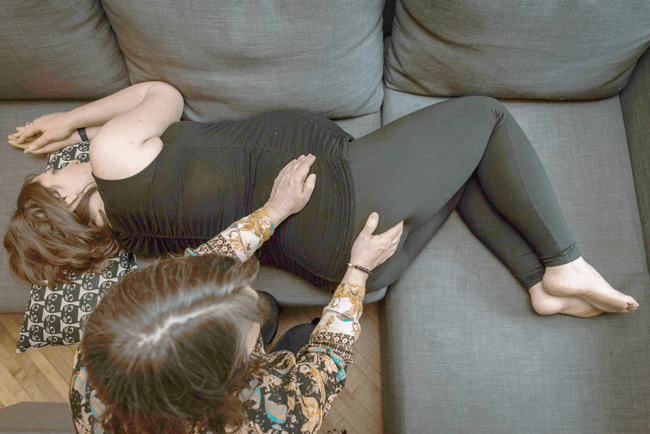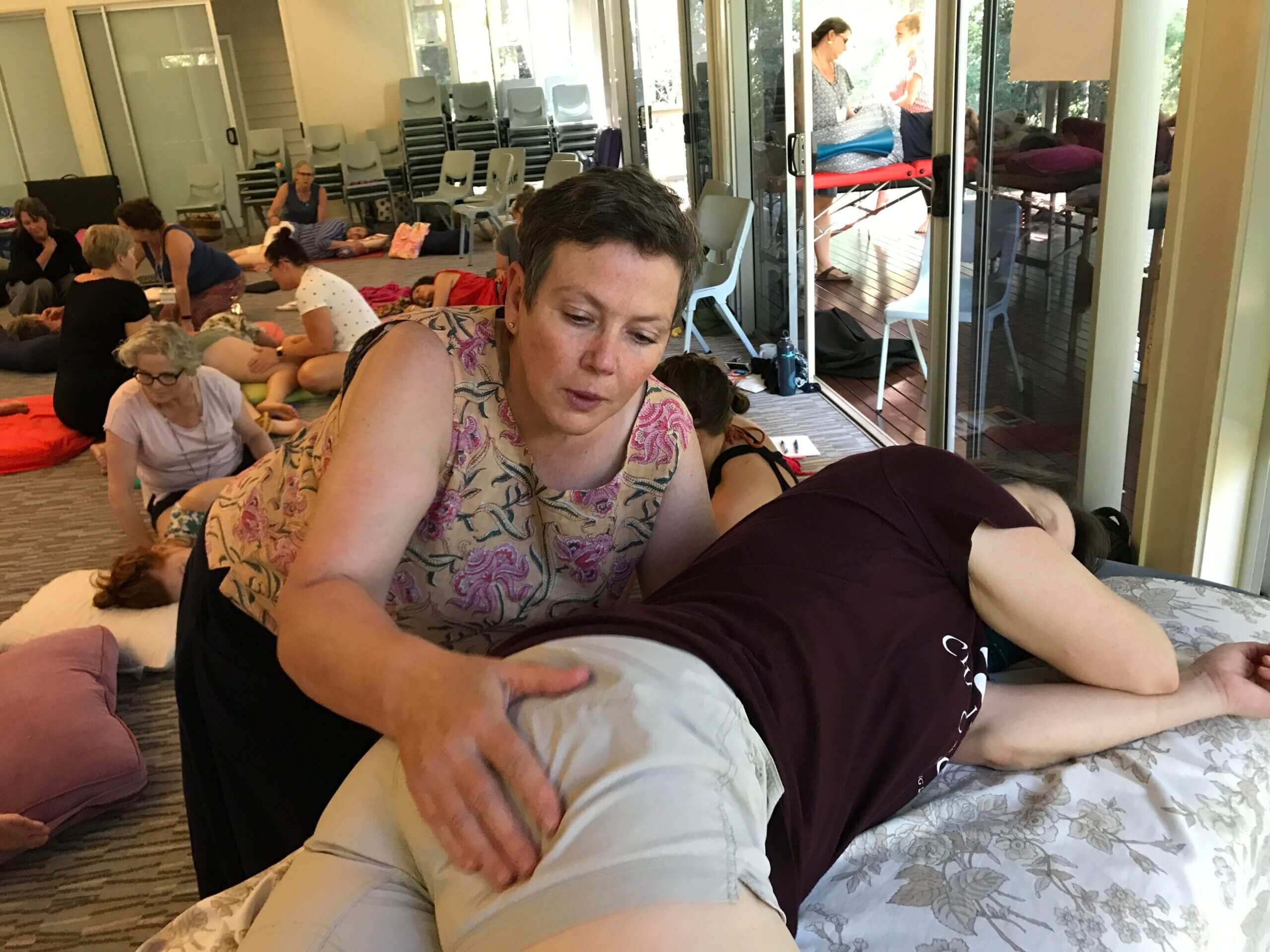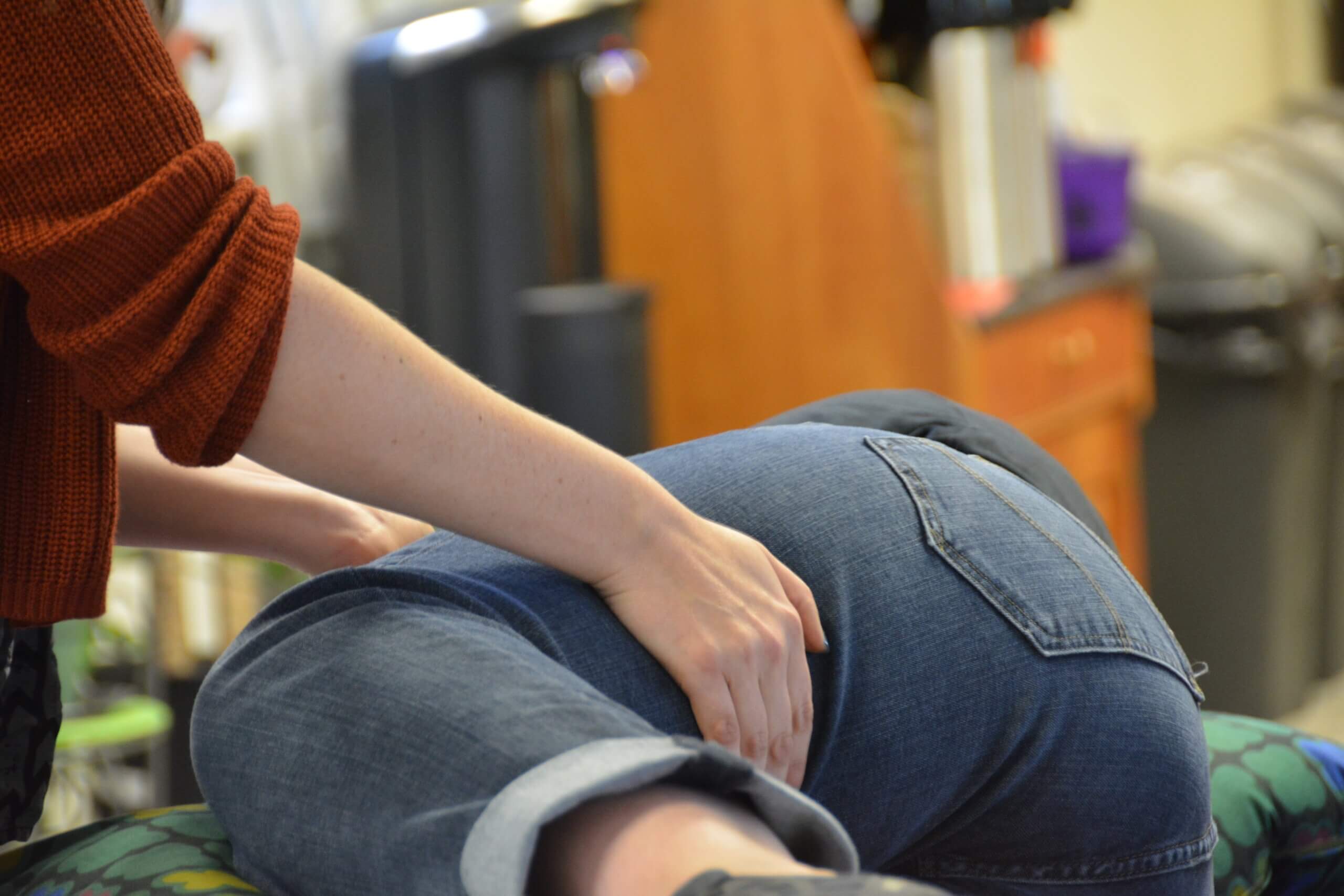Our first technique in our Three BalancesSM.
A gentle and lasting jiggle allows the body to function better.

Vibrating the legs and buttocks so that body fluids in the muscle tissues oscillate is calming and pain-reducing.
Origin to Spinning Babies®: The Jiggle in this form is an abbreviated version of Jenny Blyth’s Pelvic Jiggle and Bum Jiggle. Jenny Blyth is a Birth Attendant, a Spinning Babies® Approved Trainer, and Spinning Babies® Aware Practitioner in Australia. Jenny shares information about the value of gentle jiggle for relaxing while helping balance the nervous system.
The fascia responds to a vibration motion by increasing hydration and circulation. Improved function of the fascia allows for muscles, ligaments, and even joints to function better in turn. The sacrum itself can become a focus of the jiggle and begin to become more mobile. This could lead to an improvement in rotation and descent.
The Jiggle is one of the most luscious relaxation techniques when done with presence. There is a quality of the touch that invites trust.
Just about anyone will enjoy being jiggled. I’ll call the two people the giver and the receiver. There can be two givers, and if there are, the more they are in sync with their speed and rhythm, the more likely the relaxation will be deep. Keep conversations soothing and quiet. The receiver could fall asleep or enter a calm state of mind. Activation of the parasympathetic nervous system can restore optimal function of the lower uterine segment, which is another potential avenue to fetal rotation.
Depending on hand placement and length of jiggling, various parts of the body may be relaxed and enlivened:

Jiggle lightly. Move your hand(s) gently and steadily. Use both hands or one hand. I like two. Another likes one-handed jiggling.
In general, I would say that touching the body extremely lightly communicates with fascia whereas pressing into the body talks to the muscles. This is a generalization that is meant to remind you to lighten up your touch while you jiggle. The light action has a particular advantage to helping stiffened fascia become more “fluid” and supple.
Your grip is mild. Hold the leg or buttocks as if you were holding a sleeping 10-month-old on your shoulder, you’re not letting their body slide sideways. Too tight and they’d wake, too loose and they slip. You get it?
The receiver needs to be comfortable if they are going to get the most benefit. They lie on the left side with pillows under the knee and ankle with the left leg a bit straight and behind them. But vary the details if needed to add comfort.
Talking about something other than their comfort may be annoying, like someone turning the light on when you are asleep. Keep a quiet environment.
Jiggle for several minutes and then the helper’s hands can find a new spot to jiggle as the tissues soften and that part relaxes fully.
Starting and then stopping abruptly can also be disruptive. Tell the person you are about to end. Let your hands remain while you take one breath. Slide your hand off the body and step away to your errand.
The receiver can be standing and leaning on the bathroom sink or they can be back in bed lying on their side for this. A pillow between the knee and ankle is a must anytime someone is resting on their side. Position yourself to reach comfortably with both hands. You may need to sit. Be symmetrical in your own pelvis.

You can do one side or both sides. In other techniques, you need to do both sides, but with the Jiggle, both sides or one side is optional. It will be more effective to do one side for six minutes than two sides for three minutes, for instance. Tell that to the receiver and let them decide in case they would really like both sides of their body treated equally.
In a minute or two, the ripples make it to the hip and maybe down the opposite direction, too, to the knee. Another couple of minutes and the looseness might be felt coming around the front to the hip bone. The helper isn’t checking with their hands, they are sensing this through the thigh. Keep going and feel the relaxation extend to the pubic bone, the sitz bone, the sacrum, and even the belly. Continue for 10 to 20 minutes to feel and see the deeper relaxation and shift to a calm state.
Different people will have different ease with their fascia and in different areas. Some will have restrictions. The ripples will go to the restriction and begin inviting it to release.
As the helper, you can rearrange your hands. You can place your hand on the buttock and hip or the side of the hip and the sacrum. Start with the thigh to show your touch can be trusted and don’t change locations before a few minutes have actually passed.
It’s important that you are comfortable in your position to do this. You may want to sit. You may stand. Rearrange yourself and be symmetrical with how you settle your weight on your feet or sitting. It’s common for givers to say, I’m fine, and then within a minute or two, they feel fussy because they are using their bodies in a very asymmetrical way. Get yourself situated. Comfy, even. Supporting your elbows on the bed or your own body is a way of relaxing yourself to keep going.
Jiggle for 5 to 10 minutes for relaxation, but a full 20 minutes. You might jiggle 3 or 4 places on the thigh and buttocks over this time period.
Expect it takes at least five minutes to vibrate into the muscles and 10 minutes or more to go to the depth of the pelvic fascia, releasing ever more and more tension. Change the location of your hands and begin again. Don’t go more than an hour; a half hour may be plenty long for most people. About 20 minutes into this, the receiver may be asleep. But really, the body will tell you if you listen. Stay with the jiggle as long as you both enjoy it.
Be mindful of how the receiver of this yummy jiggle is positioned. They are lying on their side. The hips are often asymmetrical, and the top leg bent and rests forward over a peanut ball or pillows. The ankle is supported as well as the knee. Place a pillow under the thigh. This will prevent pulling at the sacroiliac joint.
As I say often, be steady and oscillating, not shaking or jerking. This is for safety as well as comfort.
The distracted jiggler with a highly caffeinated touch can bring the receiver out of sync with themselves rather than into regulation of the nervous system.
The common assumption about jiggle techniques is that the baby is blocked in the uterus or pelvis like a jar of marbles that can’t be poured out. You can add water and a jiggle and then the marbles will pour out. This is not our assumption. We are eliciting fascia receptors and helping the fibriles of connective tissue reorganize themselves and invite the kind of calm that is good to gestate in, to digest and rest in.
Don’t let the receiver tip over – you’re not that vigorous. This should feel good. You’re not shaking so much as vibrating, but vibrating apples doesn’t elicit an image. Rattling the apple tree branch sets the fruit flying. Now tone that down and make it appropriate to the fascia.
Spinning Babies® is a non-force approach. We provide the jiggle and trust the baby to make the turn once the “room becomes available.” We don’t shake. There’s a baby in there! You are not trying to shake the baby loose. The balanced body will help baby improve their position, let them move more freely and smoothly, and help them grow (along with good nutrition and abstaining from smoking and pollution).
Most birthing people won’t want to be jiggled during a contraction.
For additional education to even further enhance your pregnancy and labor preparation, shop our extensive collection of digital downloads, videos, DVDs, workbooks, and more.